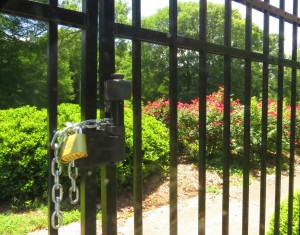By Elliott Brack | Imagine your surprise if you were going to an attraction, and when you got there, without you knowing anything about it, the gate was locked.
 That’s what happened to one Gwinnettian seeking to visit and admire the roses at the Fernbank Museum of Natural History recently. A sign on the gate said the rose garden was closed permanently. Some of the roses moved to the Governor’s Mansion for care.
That’s what happened to one Gwinnettian seeking to visit and admire the roses at the Fernbank Museum of Natural History recently. A sign on the gate said the rose garden was closed permanently. Some of the roses moved to the Governor’s Mansion for care.
Checking with Fernbank officials, we learned that because of a withdrawal of funding by the DeKalb Board of Education to the Fernbank Science Center, back in 2012, the garden has been closed. We got that from Susan Neugent, president of Fernbank.
The DeKalb schools had paid for a professional rosarian to take care of the Robert L. Staton Rose Garden. When that professional retired, the program was discontinued, leaving Fernbank to maintain the roses.
The Garden was dedicated to Staton, a former employee of the Science Center, who loved roses. His desire to educate the public, and the absence of a test site in Atlanta’s growing climate, were key forces in the birth of the concept that evolved into the garden. At one time it was one of only three gardens in the United States that had both All-American Rose Selection and American Rose Society test roses.
The Staton Garden had been used as a test garden, to see how new cultivars would do in this area. The National Test Garden funded part of this, but this connection was discontinued in 2009.
Beds in sizes about 6×30 feet were used for the roses. There were eight professional horticulturalists in the garden at one time, plus vocational students learning how to train roses. They put in hours per bush per week. (It takes 9-11 gallons of water per bush per week.)
One Fernbank official told us “The garden was never part of the Museum; it never fell into the mission of the museum; it was just on the museum grounds. We inherited the rose garden, and were seeking a ‘good home’ to care for them.”
In April, Perk Talgo, the assistant grounds manager and the landscapist in charge of the Governor’s Mansion garden, moved 200 florabunda and hybrid tea roses to the Mansion, out of about 900 bushes in the Fernbank garden. “We picked bushes which would supplement what we already had, and used some of the Fernbank roses for accent.” So far, he reports that all the bushes have been replanted and are doing well, “because they were so healthy when we got them from Fernbank.”
One person is dedicated at the Mansion to work with the roses on a weekly basis. They provide the fertilizer, insecticide and fungicide that the roses demand. Talgo says: “You have to work closely all the time with the roses at the Mansion, and spray about every 10-15 days if you want them to thrive. You look for fungus problems and black spot. It’s the humidity in the South than requires all the care for the roses. You don’t have to put in all that care up North.”
Some of the two-thirds of the garden remaining has been given to volunteers, while other bushes not requiring heavy maintenance, mainly knock-out and spray roses, remain and are in bloom. However, they do not need the constant care other roses do.
So the big florabunda and hybrid tea roses aren’t at Fernbank any more. But visit for natural and scientific exhibits.












Follow Us